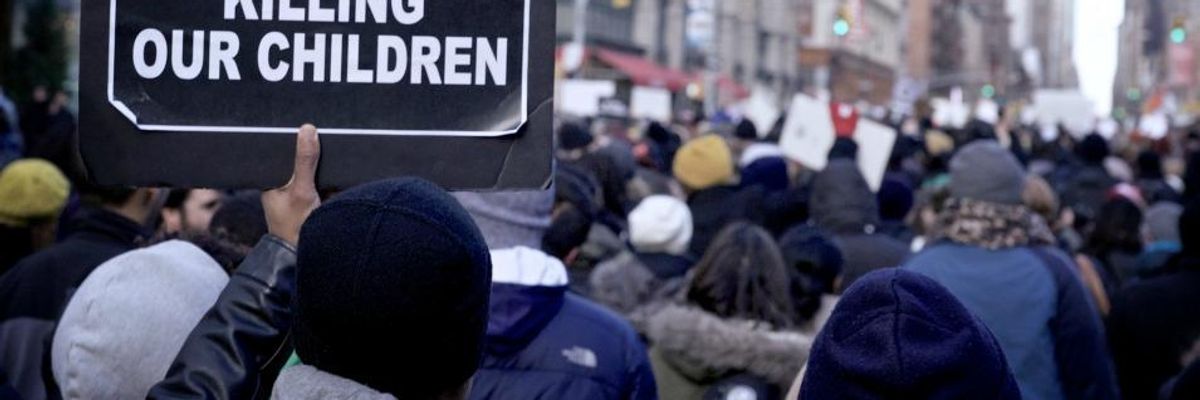In the wake of ongoing civil rights protests around the country and federal probes into institutional racism in Ferguson and beyond, two separate reports on police killings of unarmed citizens were released last week, to little fanfare. But those reports--and the organizations that published them--tell an important component of the story that was overlooked by the Justice Department in its more high-profile investigation.
Last Tuesday, the Bureau of Justice Statistics--a sub-agency within the Justice Department--released a new study (pdf) confirming that the government's own statistics on police-involved deaths of civilians have been under-reported by at least half the true number.
And on Friday, KilledByPolice.net reported that at least 167 civilians died in officer-involved encounters since the start of the year, based on information that the group put together through news clippings and other published data.
According to the BJS report, there were "an average of 928 law-enforcement homicides per year" from 2003-2009 and 2011--but those statistics only counted deaths that occurred during an arrest, and did not take into account bystander deaths, deaths at the hands of federal agents, or deaths that happened during a vehicular chase.
Even the BJS's own documentation of arrest-related deaths (ARDs) does not tally all of them, the bureau stated in its report, but roughly 36 percent of all law enforcement homicides instead.
As the Human Rights Data Analysis Group explains, the BJS report relies on "multiple systems estimation" to create its tally, a flawed method which involves using incomplete lists to fill in informational gaps. In this case, BJS relied on arrest-related deaths data and a parallel program by the FBI, known as the Supplementary Homicide Reports (SHR).
HRDAG continues:
Two-system estimates such as the one BJS published today underestimate the total number of undocumented cases when there is positive list dependence. Because it is likely that the two databases used in this analysis are positively dependent, it is therefore very likely that these estimates are only a lower bound. In reality, it is likely that much more than 28% of all police homicides go unreported by the ARD and the SHR.
While the BJS report acknowledges these shortcomings in its methodology, its findings are no surprise to independent auditors of police-involved killings.
"These findings are basically what we've been saying for more than a year," D. Brian Burghart, who operates FatalEncounters.org, told Common Dreams.
In November, the FBI released data which found that fatal police shootings were higher in 2013 than they have been in two decades--but as Burghart said at the time, those numbers were based on a small parameter of so-called "justifiable homicides" voluntarily reported by police departments who happen to keep track of the information, leaving the real statistics unknown.
In December, Congress authorized the Death in Custody Reporting Act, which will require all states that receive federal criminal justice assistance grants to report all deaths that occur in law enforcement custody to the BJS. The BJS will in turn be expected to compile that data, along with news articles, coroner's reports, and other information to create a more complete picture of officer-related deaths than what can be gleaned from FBI statistics.
Recent civil rights protests forced national attention onto the lack of accountability for police who killed civilians, leading FBI director James Comey to remark in a speech last month, "It's ridiculous I can't tell you how many people were shot by police in this country last week, last year, the last decade."
Until these events, those who sought more information could only look to independent auditing organizations like Killed by Police and Fatal Encounters for accurate information.
Yet according to Burghart, the first reports to come out of the Death in Custody Reporting Act are likely to highlight a wide discrepancy between federal statistics on police-involved killings and those compiled by independent organizations, particularly as they focus on arrest-related deaths. "People are going to compare our numbers to the FBI reporting numbers and discover that their numbers... are lower," he said. "It's almost like they're preparing the public for low numbers."
In two years, when the first Death in Custody Reporting Act statistics come out, "we'll be able to compare our information to theirs," Burghart said. "I think that will be the indication of what the future is."
As criminal justice news organization The Marshall Project points out, the BJS was "supposedly harvesting information from a wide range of sources" for years before the Death in Custody Reporting Act was passed, and still "fell far short of a complete tally."
The FBI has not disclosed any plans to change its data collection methods.
There are other elements which concern the public that are missing from the BJS report, which a focus on statistics helps obscure, Burghart says. "The first [media] reports are always the police story, their narrative... and then you get down the road and the press has forgotten about it by the time the reports have come out," he said. "We never hear what the true story is, not even from the cop's point of view."
Referring to the BJS report, Burghart continued, "The Justice Department has gone into many cities and discovered these issues, so I don't see this one as changing anything." However, he added, "This is the first time I've ever seen the government admit that the numbers they were providing to the public were shit, so that's a great turning point."



